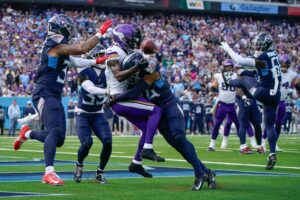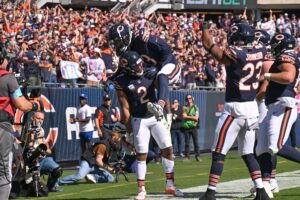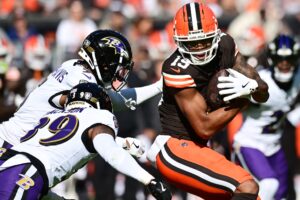The NFL season is right around the corner, and teams are officially beginning their training camps. The Philadelphia Eagles have one of the most interesting running back situations in the league, as second-year pro Miles Sanders looks ready to take a leap. However, Sanders isn’t the only name in town. Running back is one of the most injury prone positions in football, and head coach Doug Pederson typically uses a committee approach at the position. Let’s take a look at all the names on the depth chart and see how they fit on the 2020 Eagles.
2020 Training Camp Preview: Philadelphia Eagles Running Back
The Starter: Miles Sanders
2019 second-round pick Miles Sanders has a chance to develop into a legitimate star in Year 2. As a rookie, the Penn State product played in just 52% of the snaps but still managed to make a big impact. Overall, the rookie recorded 818 rushing yards and three touchdowns on 179 carries while adding an additional 50 receptions, 509 yards, and three touchdowns as a receiver. Sanders’ 229 combined touches was the most of any running back of the Doug Pederson Era, but that doesn’t even tell the full story with Sanders.
Sanders started the year splitting snaps with Jordan Howard but became the unquestioned starter in Week 11. From Weeks 11-16 (the Eagles rested Sanders for most of Week 17 once they had their playoff spot locked up), Sanders was on pace for 251 carries and 67 receptions for 547 yards. He was one of the most explosive players in the offense and one of Carson Wentz’ most reliable options in the passing game.
Right now, it looks like Sanders will take on a true workhorse role in Philadelphia’s backfield. Assistant Head Coach Duce Staley said that he’s “excited about [Sanders] handling the full load” and the Eagles didn’t bring in any other running back competition. Jordan Howard is gone, and Miles Sanders should have a huge year in this offense.
The Primary Backup: Boston Scott
Miles Sanders is going to be the starter, but Boston Scott is more than capable of taking over should Sanders suffer an injury. The former sixth-round pick took a while to see the field, but ultimately proved to be a fairly effective player when given his chance to shine. Last year, Scott averaged a solid four yards-per-carry on 61 rushing attempts. However, he truly made his mark in the passing game, hauling in 24 of his 26 receptions for 204 yards and 8.5 yards per reception.
Like Sanders, Scott saw most of his work towards the end of the season. In Week 14 against the New York Giants, Scott recorded 10 carries for 59 yards and a touchdown to go along with six receptions for 69 yards. This was the first time in his career he played in more than 20% of the offensive snaps, and he proved that he could handle starting reps if injury struck. Scott proved that wasn’t a one-week fluke, as he averaged 4.0 yards per carry and 8.65 yards per reception for the remainder of the season.
The Eagles refusing to bring in another running back speaks to the teams’ trust in Scott just as much as Sanders. Boston Scott is a better receiver than a runner, but he’s completely competent between the tackles. Chances are, he’ll play about 30-35% of the snaps and serve as a nice change-of-pace back for Sanders.
Special Teams Depth: Corey Clement
This is where things start getting interesting. Corey Clement had the chance to prove himself a viable starter back in 2018, but he completely dropped the ball. After injury struck Jay Ajayi, Clement had the chance to prove he was more than just a pass-catching specialist. Instead, he averaged just 3.8 yards per carry while failing to record a single start.
Clement played in four games last year, but spent all of his time on special teams. The former undrafted free agent didn’t record a single offensive touch all season long before hitting the injured reserve with a shoulder injury. The Eagles didn’t even bother to place a restricted free agent tender on him, although they ended up re-signing him to a one-year deal.
Clement is nothing more than a depth piece, but he proved that he can be a competent third-down back in the right environment. After all, this is still the same guy that averaged 9.8 yards per receptions through his first two seasons in the league. He’ll clearly make his home on special teams, but might catch a few passes here and there throughout the season.
The Rest: Elijah Holyfield, Michael Warren, Adrian Killins
Elijah Holyfield, Michael Warren, and Adrian Killins are likely fighting for one roster spot. Holyfield initially joined the NFL as an undrafted free agent with the Carolina Panthers. He couldn’t make the active roster, but the team liked him enough to keep him around on the practice squad. Holyfield made a brief cameo on Philadelphia’s active roster last year, but didn’t earn a single touch.
For all intents and purposes, Elijah Holyfield is the anti-Corey Clement. The Georgia product hardly ever contributed to the passing game in college, and there isn’t any reason to believe that will change in the NFL. Instead, he’s the type of guy that can move the chains in short-yardage work and break a few tackles in the process. While he lacks breakaway speed, he could stick around as a poor man’s LeGarrette Blount.
Michael Warren is built in a similar mold to Holyfield. The Cincinnati product is a physical runner that has the ability to push over smaller defenders and make slower defenders miss in space. Like Holyfield, he isn’t going to break off too many long runs or make too many plays in the passing game.
Adrian Killins is the exact opposite of these two. The UCF product is an absolute speedster and has the potential to take it to the house every time he touches the ball. He’s better as a receiver than a runner, but his 164-pound frame and subpar pass protection makes him a longshot for the roster.
Main photo:
Embed from Getty Images






